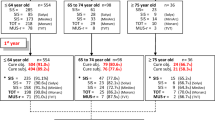Abstract
Introduction and hypothesis
The primary aim was to characterize stress urinary incontinence (SUI) symptom distress and impact after a midurethral sling (MUS) in women ≥70 compared to women <70 years of age.
Methods
A retrospective cohort study of women undergoing a primary MUS was conducted. The primary outcome was SUI symptoms defined as either “moderately” or “quite a bit” responses to ≥1 of the two SUI questions of the Pelvic Floor Distress Inventory-20 (PFDI-20). Urgency urinary incontinence (UUI) was defined as either moderately or quite a bit responses to the UUI question of the PFDI-20. The Pelvic Floor Impact Questionnaire (PFIQ-7), Patient Satisfaction Questionnaire (PSQ), and Patient Global Impression of Improvement (PGI-I) questionnaires were also administered.
Results
The mean age of patients ≥70 years (n = 160) was 75.4 ± 4.5 and <70 years (n = 536) was 56.2 ± 9.4. Multivariable analysis revealed no difference in SUI failure rates in older compared to younger cohorts, adjusted odds ratio (OR) 1.7, 95 % confidence interval (CI) 0.9–3.1. Women <70 demonstrated greater improvement in urinary incontinence (UI) symptom impact [−20.4 (33.0) vs −12.2 (30.7), p = 0.01] and women ≥70 had greater persistent UUI symptoms (31.5 vs 23.3 %, p = 0.04); there was no difference between cohorts in resolution of UUI (29.6 vs 34.2 %, p = 0.34). Younger women reported a greater impression of improvement compared to older women (67.7 vs 56.6 %, p = 0.01, respectively).
Conclusions
Older and younger women have similar SUI outcomes after MUS; however, older women have more persistent UUI and a worse impression of improvement of their urinary tract condition.
Similar content being viewed by others
References
Groth T, Guralnick ML, O’Connor RC (2007) Review of female stress urinary incontinence. Minerva Med 98:203–209
Nilsson CG, Palva K, Rezapour M et al (2008) Eleven years prospective follow-up of the tension-free vaginal tape procedure for treatment of stress urinary incontinence. Int Urogynecol J Pelvic Floor Dysfunct 19:1043–1047
Oliphant SS, Wang L, Bunker CH et al (2009) Trends in stress urinary incontinence inpatient procedures in the United States, 1979–2004. Am J Obstet Gynecol 200:521.e1–521.e6
Richter H, Albo ME, Zyczynski HM et al (2010) Retropubic versus transobturator midurethral slings for stress incontinence. N Engl J Med 362:2066–2076
Anger JT, Litwin MS, Wang Q et al (2007) The effect of age on outcomes of sling surgery for urinary incontinence. J Am Geriatr Soc 55:1927–1931
Parden A, Gleason J, Jauk V et al (2013) Incontinence outcomes in women undergoing primary and repeat midurethral sling procedures. Obstet Gynecol 121:273–278
Ulmsten U, Henriksson L, Johnson P et al (1996) An ambulatory surgical procedure under local anesthesia for treatment of female urinary incontinence. Int Urogynecol J Pelvic Floor Dysfunct 7:81–85
Delorme E (2001) Transobturator urethral suspension: mini-invasive procedure in the treatment of stress urinary incontinence in women. Prog Urol 11:1306–1313
Barber MD, Chen Z, Lukacz E et al (2011) Further validation of the short form versions of the Pelvic Floor Distress Inventory (PFDI) and Pelvic Floor Impact Questionnaire (PFIQ). Neurourol Urodyn 30:541–546
Yalcin I, Bump R (2003) Validation of two global impression questionnaires for incontinence. Am J Obstet Gynecol 189:98–101
Burgio KL, Goode PS, Richter HE et al (2006) Global ratings of patient satisfaction and perceptions of improvement with treatment for urinary incontinence: validation of three global patient ratings. Neurourol Urodyn 25:411–417
Stav K, Dwyer PL, Rosamilia A et al (2010) Midurethral sling procedures for stress urinary incontinence in women over 80 years. Neurourol Urodyn 29:1262–1266
Barber MD, Spino C, Janz NK et al (2009) The minimum important differences for the urinary scales of the Pelvic Floor Distress Inventory and Pelvic Floor Impact Questionnaire. Am J Obstet Gynecol 200:580.e1–580.e7
Nager C, Sirls L, Litman H et al (2011) Baseline urodynamic predictors of treatment failure 1 year after midurethral sling surgery. J Urol 186:597–603
Acknowledgments
Partially funded by the National Institutes of Diabetes and Digestive and Kidney Diseases to HER 2 K24-DK068389.
Conflicts of interest
None.
Author information
Authors and Affiliations
Corresponding author
Rights and permissions
About this article
Cite this article
Malek, J.M., Ellington, D.R., Jauk, V. et al. The effect of age on stress and urgency urinary incontinence outcomes in women undergoing primary midurethral sling. Int Urogynecol J 26, 831–835 (2015). https://doi.org/10.1007/s00192-014-2594-4
Received:
Accepted:
Published:
Issue Date:
DOI: https://doi.org/10.1007/s00192-014-2594-4




